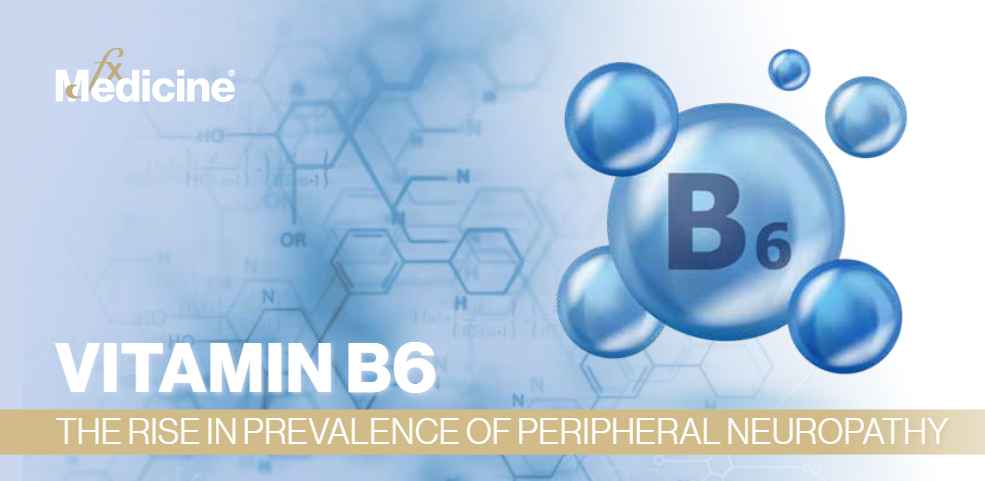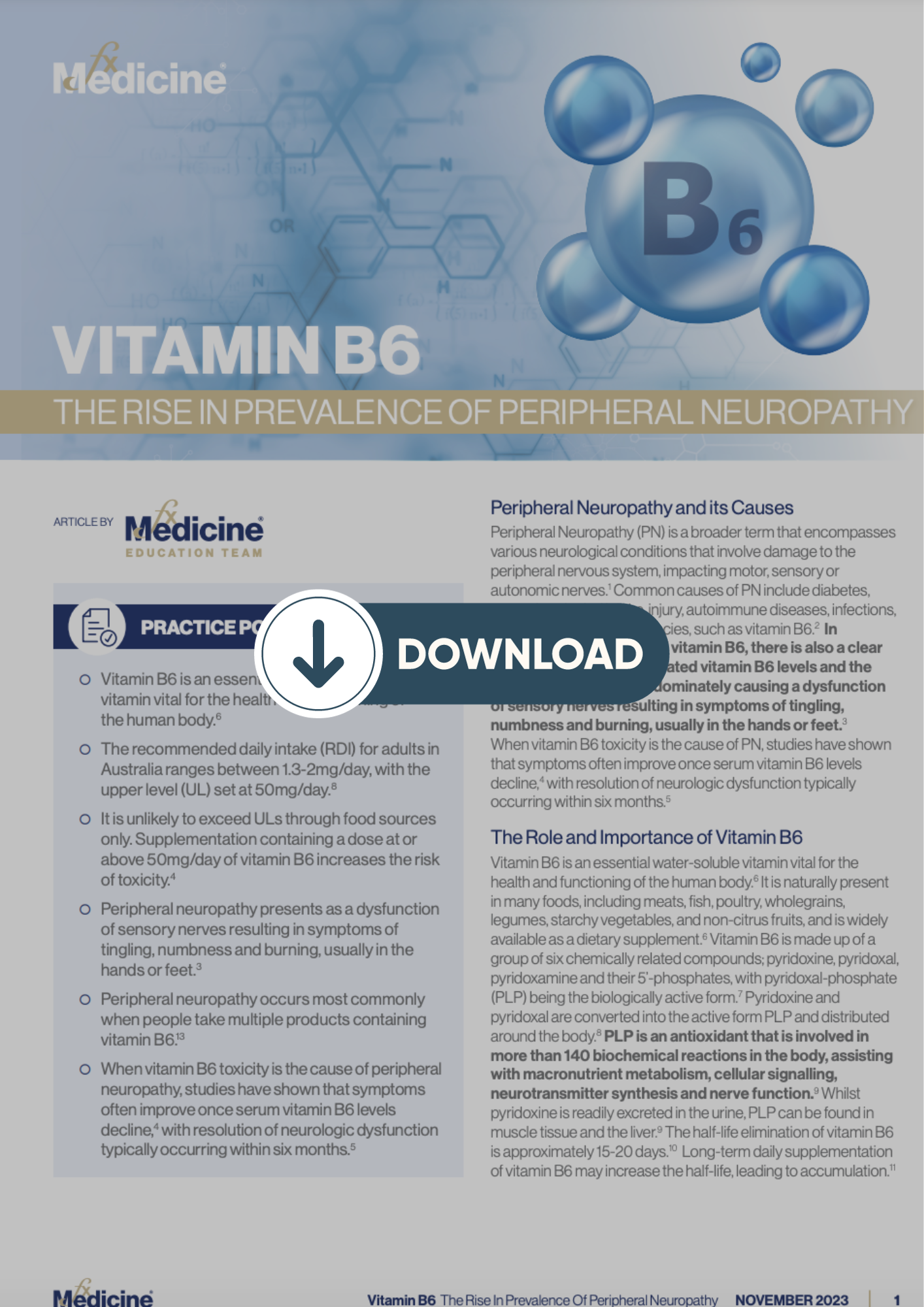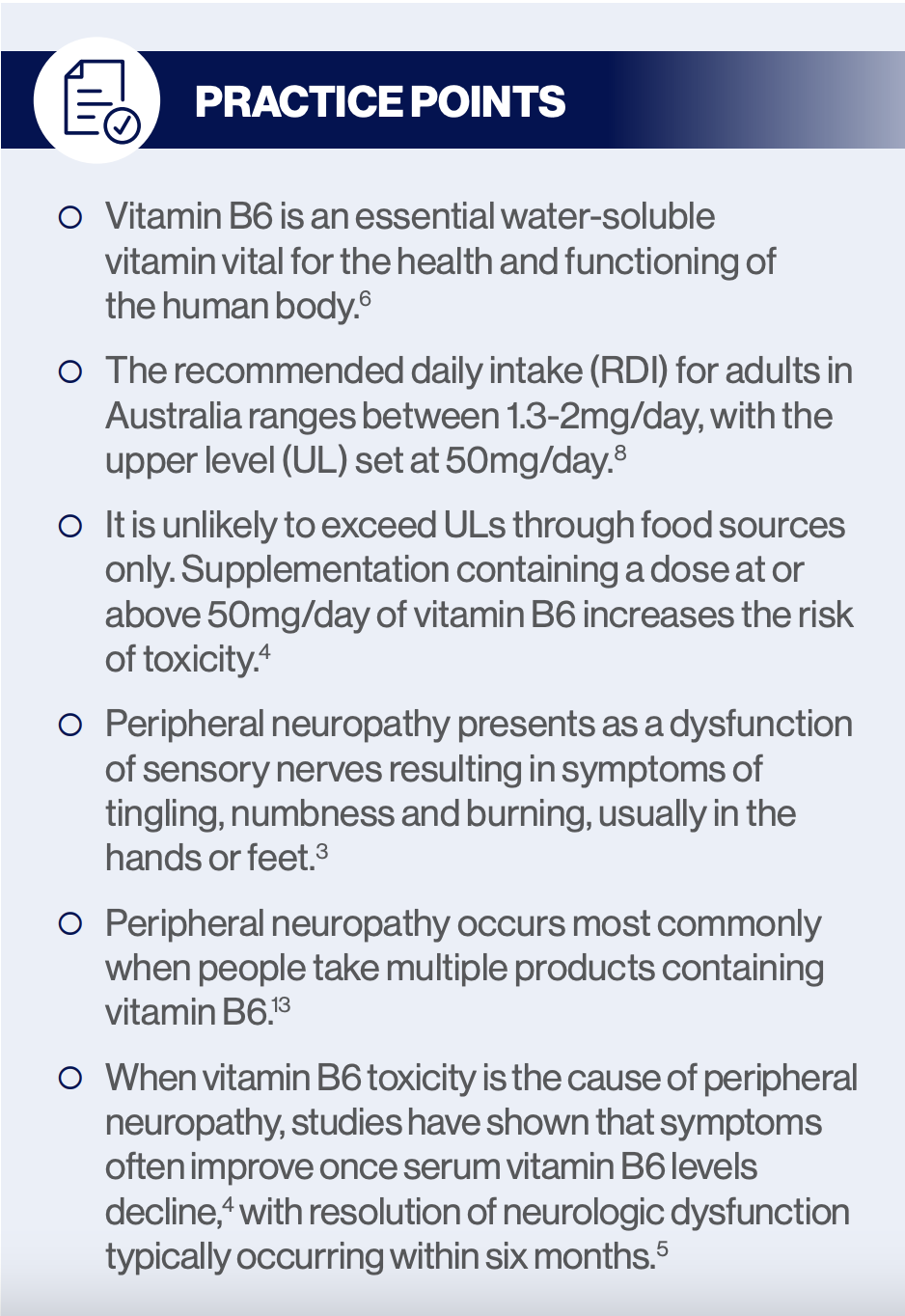 Peripheral Neuropathy and its Causes
Peripheral Neuropathy and its Causes
Peripheral Neuropathy (PN) is a broader term that encompasses various neurological conditions that involve damage to the peripheral nervous system, impacting motor, sensory or autonomic nerves.1 Common causes of PN include diabetes, excessive alcohol intake, injury, autoimmune diseases, infections, and certain vitamin deficiencies, such as vitamin B6.2 In addition to a deficiency of vitamin B6, there is also a clear association between elevated vitamin B6 levels and the development of PN, predominately causing a dysfunction of sensory nerves resulting in symptoms of tingling, numbness and burning, usually in the hands or feet.3 When vitamin B6 toxicity is the cause of PN, studies have shown that symptoms often improve once serum vitamin B6 levels decline,4 with resolution of neurologic dysfunction typically occurring within six months.5
The Role and Importance of Vitamin B6
Vitamin B6 is an essential water-soluble vitamin vital for the health and functioning of the human body.6 It is naturally present in many foods, including meats, fish, poultry, whole grains, legumes, starchy vegetables, and non-citrus fruits, and is widely available as a dietary supplement.6 Vitamin B6 is made up of a group of six chemically related compounds; pyridoxine, pyridoxal, pyridoxamine and their 5’-phosphates, with pyridoxal-phosphate (PLP) being the biologically active form.7 Pyridoxine and pyridoxal are converted into the active form PLP and distributed around the body.8 PLP is an antioxidant that is involved in more than 140 biochemical reactions in the body, assisting with macronutrient metabolism, cellular signalling, neurotransmitter synthesis and nerve function.9 Whilst pyridoxine is readily excreted in the urine, PLP can be found in muscle tissue and the liver.9 The half-life elimination of vitamin B6 is approximately 15-20 days.10 Long-term daily supplementation of vitamin B6 may increase the half-life, leading to accumulation.11
Recommended Daily Intake and Potential Toxicity of Vitamin B6
In Australia, the recommended daily intake (RDI) for adult’s ranges between 1.3-2mg/day, with the upper level (UL) set at 50mg/day.8 Food consumption is estimated to provide up to 5mg/day of vitamin B6 in adults, with supplementation contributing up to 80% of daily intake.4 It is unlikely for an adult to exceed ULs through food sources only. Supplementation containing a high dose, at or above 50mg/day, of vitamin B6 increases the risk of toxicity.4
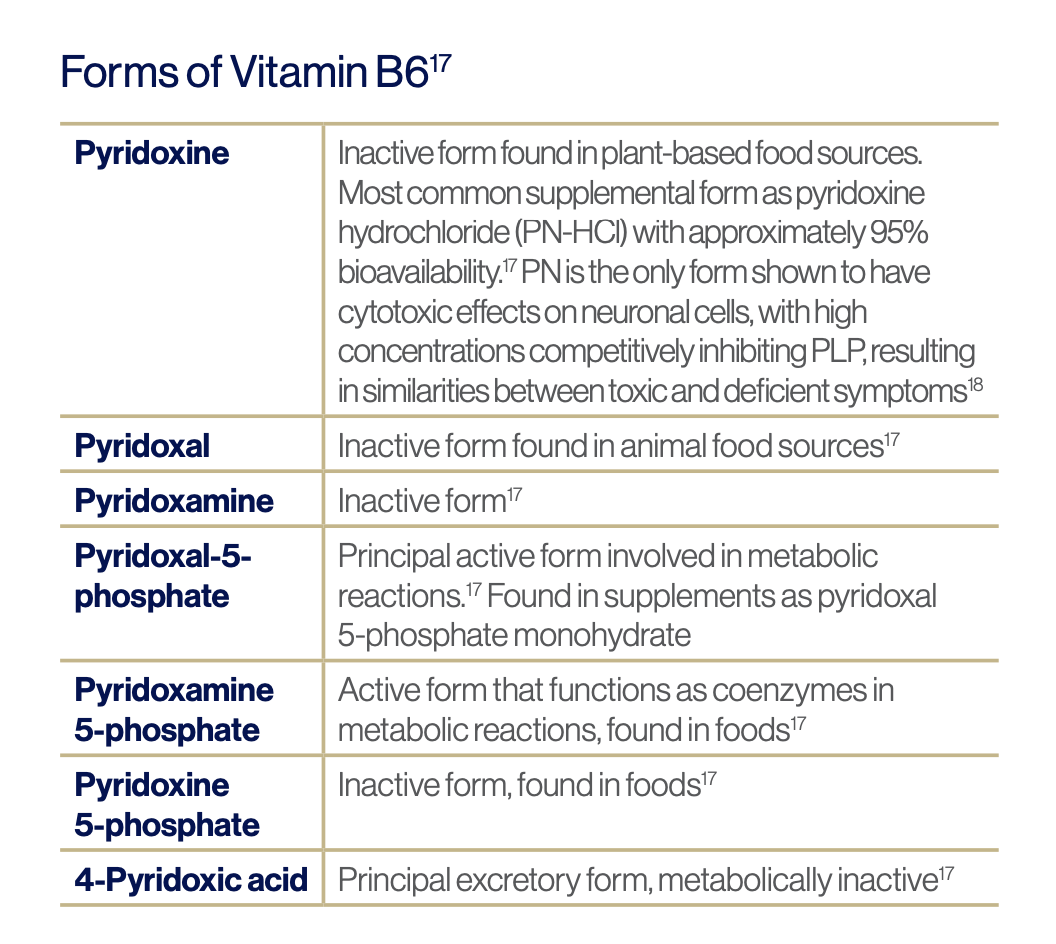
Hypothesised Mechanism of Vitamin B6-Induced Neuropathy
The mechanism through which vitamin B6 toxicity can lead to neuropathy is unclear, but it has been hypothesised to be a result of pyridoxine inhibiting pyridoxal kinase (PDXK) activity, thus reducing γ-aminobutyric acid (GABA) synthesis and decreasing GABA signalling within sensory neurons.11 As GABA is an inhibitory neurotransmitter,12 decreased GABA neurotransmission can damage sensory nerves.11
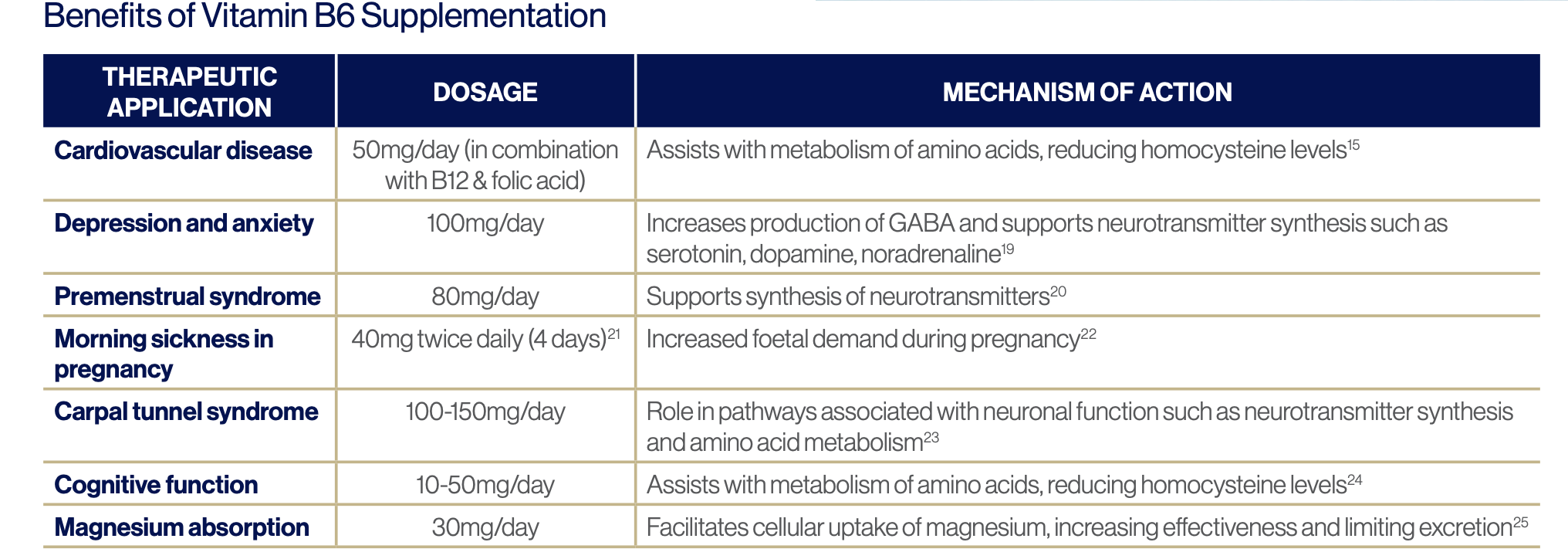
The Variance of Sensitivity to Vitamin B6 Toxicity
The Therapeutic Goods Administration (TGA) has reported that the risk of developing PN from vitamin B6 toxicity varies greatly between individuals; in some people, it occurs from doses less than 50mg/day.13 Plasma PLP is the most common measure of vitamin B6 status. PLP concentrations of more than 30 nmol/L have been traditional indicators of adequate vitamin B6 status in adults.15
Prevalence and Source of Vitamin B6 in Australian Medicines
In Australia, there are currently more than 1,500 medicines containing vitamin B6 including multivitamins, vitamin B complexes and magnesium and zinc supplements.13 PN appears to occur most commonly when people unknowingly take multiple products containing vitamin B6.13 Vrolijk et al., 2020 also reported that Pyridoxine, the most common form found in supplements, has a cytotoxic effect on neuronal cells, and this is considered more influential on the development of PN than vitamin B6 dosage.14
Regulatory Changes in Response to Vitamin B6 Induced PN
To address the rising prevalence of PN from elevated vitamin B6 levels, the TGA announced regulatory changes in March 2022. A warning label is to be added to products containing a daily dose of more than 10mg of vitamin B6, and the maximum daily dosage of vitamin B6 in a single product has been reduced from 200mg to 100mg for adults.16 Vitamin B6 is an important micronutrient required for various functions within the body. Adequate levels are crucial for optimal health, with PN a potential consequence in both deficient and toxic states.
The tightening of regulations by the TGA has increased the safety of supplementation. Although some people develop PN when supplementation is low dose, a much higher risk occurs when taking more than one supplement containing vitamin B6. Many reports suggest people are unaware of just how much vitamin B6 they are consuming via supplementation. Whilst there is no specific treatment for pyridoxine toxicity, cessation of supplements containing pyridoxine and individualised symptom management is crucial,4 with resolution of neurologic dysfunction typically occurring within six months. Both consumer and practitioner education to increase awareness is essential. Further research to investigate the relationship between vitamin B6 and PN, including individual differences and certain vitamer forms used in supplements, is warranted.
Download a PDF version of this article
References
1. Lehmann HC, Wunderlich G, Fink GR, Sommer C. Diagnosis of peripheral neuropathy. Neurol Res Pract. 2020 Jul 15;2(1). https://doi.org/10.1186/s42466-020-00064-2
2. Health Direct. 2020. Peripheral neuropathy [Internet]. Health Direct/Australian Government; ACT. Available from: https://www.healthdirect.gov.au/peripheral-neuropathy
3. Muhamad R, Akrivaki A, Papagiannopoulou G, Periklis Zavridis, Panagiotis Zis. The role of vitamin b6 in peripheral neuropathy: a systematic review. 2023 Jun 21;15(13):2823–3. https://doi.org/10.3390/nu15132823
4. Turck D, Bohn T, Castenmiller J, Stefaan de Henauw, Karen-Ildico Hirsch-Ernst, Helle Katrine Knutsen, et al. Scientific opinion on the tolerable upper intake level for vitamin B6. EFSA J. 2023 May 1;21(5):e080006. https://doi.org/10.2903/j.efsa.2023.8006
5. Hemminger A, Wills BK. Vitamin B6 toxicity [Internet]. StatPearls Publishing; 2023. [updated 2023 Feb 7; cited 2023 Aug 24]. Available from: https://www.ncbi.nlm.nih.gov/books/NBK554500/
6. Parra M, Stahl S, Hellmann H. Vitamin B6 and its role in cell metabolism and physiology. Cells. 2018 Jul 22;7(7):84. https://doi.org/10.3390/cells7070084
7. Stach K, Stach W, Augoff K. Vitamin B6 in health and disease. Nutrients. 2021 Sep 17;13(9):3229. https://doi.org/10.3390/nu13093229
8. Eat For Health. 2021. Vitamin B6 [Internet]. Eat for Health/Australian Government. [cited 2023 Aug 24]. Available from: https://www.eatforhealth.gov.au/nutrient-reference-values/nutrients/vita...
9. Hechtman, L. (2019) Clinical Naturopathic Medicine. Second edn. Chatswood, NSW: Elsevier.
10. Sista SRS, Lozowska D, Katzin LW, Vu TH. Multivitamin supplements and energy drinks in pyridoxine megavitaminosis. Neurology: Clinical Practice [Internet]. 2015 Dec 1 [cited 2021 Oct 15];5(6):509–11. Available from: https://www.ncbi.nlm.nih.gov/pmc/articles/PMC5802477
11. Hadtstein, F. and Vrolijk, M. Vitamin B-6-induced neuropathy: exploring the mechanisms of pyridoxine toxicity. Advances in Nutrition, 2021 12(5), pp.1911-1929. https://doi.org/10.1093/advances/nmab033
12. Jewett BE, Sharma, S. GABA. [Internet]. StatPearls Publishing; 2022. [updated 2023 Jul 24; cited 2023 Aug 24]. Available from: https://www.ncbi.nlm.nih.gov/books/NBK513311/
13. Therapeutic Goods Administration. 2022. Health supplements containing vitamin B6 can cause peripheral neuropathy [Internet]. [updated 2022 Nov 10; cited 2023 Aug 24]. Available from: https://www.tga.gov.au/news/
safety-alerts/health-supplements-containing-vitamin-b6-can-cause-peripheral-neuropathy
14. Vrolijk MF, Hageman GJ, van de Koppel S, van Hunsel F, Bast A. Inter-individual differences in pharmacokinetics of vitamin B6: A possible explanation of different sensitivity to its neuropathic effects. Pharma Nutr. 2020 Jun;12:100188. https://doi.org/10.1016/j.phanu.2020.100188
15. National Institutes of Health. 2023. Vitamin B6 [Internet]. [cited 2023 Aug 24]. Available from: https://ods.od.nih.gov/factsheets/VitaminB6-HealthProfessional
16. Therapeutic Goods Administration. 2022. Peripheral neuropathy with supplementary vitamin B6 (pyridoxine) [Internet]. [updated 2022 Oct 4; cited 2023 Aug 24]. Available from: https://www.tga.gov.au/news/safety-updates/peripheral-neuropathy-supplem...
17. EFSA Panel on Dietetic Products, Nutrition and Allergies (NDA). Dietary reference values for vitamin B6. EFSA Journal. 2016 Jun;14(6):e04485. https://doi.org/10.2903/j.efsa.2016.4485
18. Vrolijk MF, Opperhuizen A, Jansen EH, Hageman GJ, Bast A, Haenen GR. The vitamin B6 paradox: Supplementation with high concentrations of pyridoxine leads to decreased vitamin B6 function. Toxicology In Vitro. 2017 Oct 1;44:206-12. https://doi.10.1016/j.tiv.2017.07.009
19. Field DT, Cracknell RO, Eastwood JR, Scarfe P, Williams CM, Zheng Y, Tavassoli T. High‐dose Vitamin B6 supplementation reduces anxiety and strengthens visual surround suppression. Hum Psychopharmacol Clin Exp. 2022 Nov;37(6):e2852. https://doi.org/10.1002/hup.2852
20. Retallick-Brown H, Blampied N, Rucklidge JJ. A pilot randomized treatment-controlled trial comparing vitamin B6 with broad-spectrum micronutrients for premenstrual syndrome. J Altern Complement Med. 2020 Feb 1;26(2):88-97. https://doi.org/10.1089/acm.2019.0305
21. Sharifzadeh F, Kashanian M, Koohpayehzadeh J, Rezaian F, Sheikhansari N, Eshraghi N. A comparison between the effects of ginger, pyridoxine (vitamin B6) and placebo for the treatment of the first trimester nausea and vomiting of pregnancy (NVP). J Matern Fetal Neonatal Med. 2018 Oct 2;31(19):2509-14. https://doi.org/10.1080/14767058.2017.1344965
22. Hasan A, Dubey AK, Bhat MS. Pyridoxine: The 'Ba.Six' of use in nausea and vomiting of pregnancy. J Clin Diagnost Res. 2019 May 1;13(5). https://doi.org/10.7860/JCDR/2019/40826.12855
23. Talebi M, Andalib S, Bakhti S, Ayromlou H, Aghili A, Talebi A. Effect of vitamin b6 on clinical symptoms and electrodiagnostic results of patients with carpal tunnel syndrome. Adv Pharm Bulletin. 2013 Dec;3(2):283. https://doi.org/10.5681/apb.2013.046
24. Li S, Guo Y, Men J, Fu H, Xu T. The preventive efficacy of vitamin B supplements on the cognitive decline of elderly adults: a systematic review and meta-analysis. BMC geriatrics. 2021 Dec;21(1):1-4. https://doi.org/10.1186/s12877-021-02253-3
25. Pouteau E, Kabir-Ahmadi M, Noah L, Mazur A, Dye L, Hellhammer J, Pickering G, Dubray C. Superiority of magnesium and vitamin B6 over magnesium alone on severe stress in healthy adults with low magnesemia: A randomized, single-blind clinical trial. PloS one. 2018 Dec 18;13(12):e0208454. https://doi.org/10.1371/journal.pone.0208454


